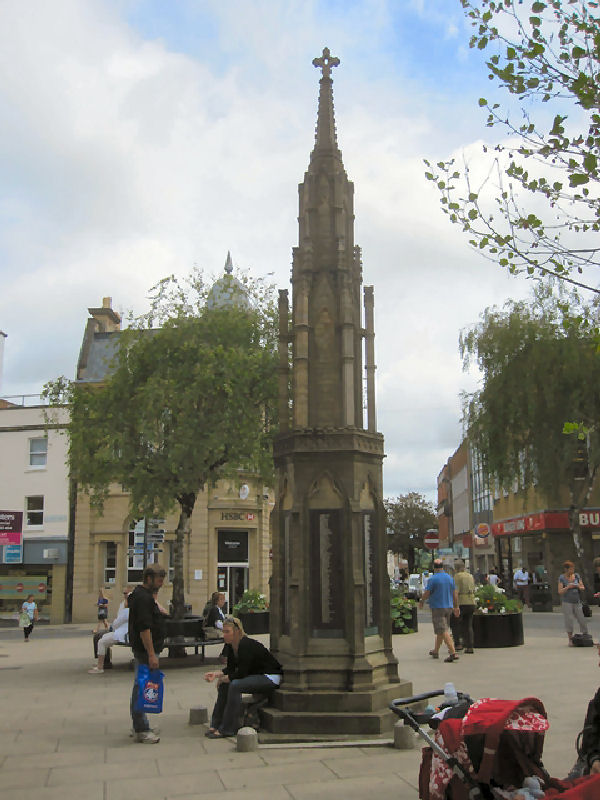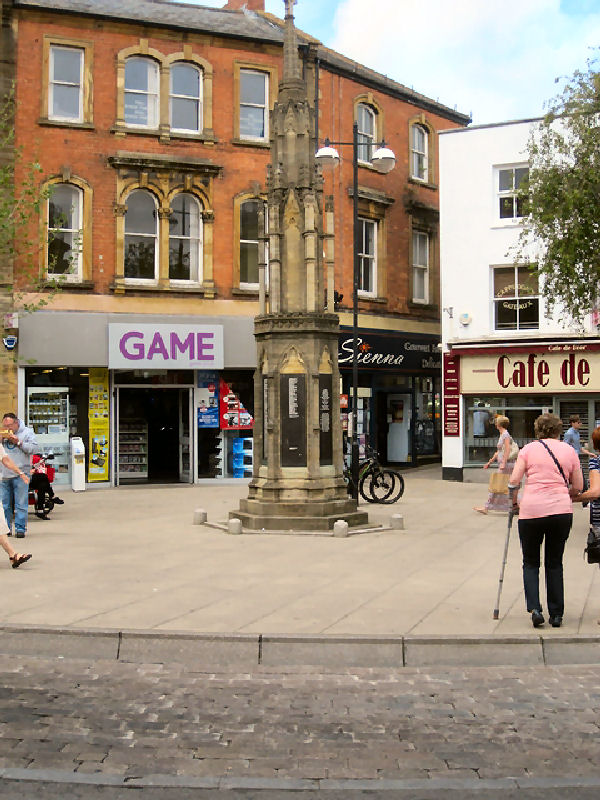
YEOVIL WAR MEMORIAL
World
War 1 & 2 - Detailed information
Compiled
and Copyright © Transcribed Robin Clay 2018
Research Martin Edwards
The
memorial is to be found in the Wine Street Triangle, Yeovil, Somerset.
It takes the form of an Eleanor cross mounted on octagonal castellated
plinth that has Gothic arch insets with plaques with names mounted within.
There are 236 names listed for World War 1 and 116 for World War 2,
there is an additional name under 'Other Conflicts'. The names have
been sorted into alphabetical order here for ease of reading and research.
The memorial was first unveiled 15 July 1921 by Mayor Alderman W. R.
E. Mitchelmore and Mayor Lieut. Col. F.D. Unwick D.S.O. The World War
2 memorial includes civilians killed in Air Raids. Please note that
there are several mispellings on the memorial, possible duplications,
and some glaring ommissions for civilians which are noted.
Extract
from Western Chronicle - Friday 22 July 1921, page 4:
YEOVIL’S
WAR MEMORIAL.
The
principal event of the week in Yeovil waa the unveiling of the War
Memorial which had been erected in the Borough in memory of the 236
Yeovllians who laid down their lives in Freedom’s cause. The
memorial ia beautiful structure—which has been much admired
by the townspeople generally—and for generations to come will
bear silent yet eloquent witness to the valour and heroismof the men
of Yeovil who in the Great War “died that we might live.”
No wonder that the people of the town assembled in their thousands
to pay a sincere tribute of gratitude and affection to the fallen
heroes. The following stanza from Cowen’s part song,
“The
Heroes,” no doubt expressed the feelings of all present ;
All
hail to them ! all hail to them !
Wheree'r
at rest they lie;
Though time departs, within our hearts
Their names shall never die.”
It seemed aeooedanee with the fitness of things that our esteemed
townsman, Col. Urwick, who had taken such an honourable part in the
war, should have been selected by the Committee to unveil the Memorial,
and right well he performed a somewhat difficult task. The Mayor (Alderman
Mitchelmore), as the chief citizen of the town, in a short address
made appropriate reference to the valour and self-sacrifice of the
Yeovil men who had fallen. He said the Memorial had been erected as
“a token of love, respect and gratitude "—a happy
phrase which sums up the general feeling. Other details of the deeply
interesting proceedings will be found fully set forth elsewhere, and
it only remains to add that the ceremony was a most impressive one,
and will be long remembered by those who participated in it. The War
Memorial Committee (with the Mayor as chairman and Mr. F. Whitmash
Mayo as the indefatigable secretary) are to be congratulated on the
successful results of their labours.
 |
|
Photographs
Copyright © Robin Clay 2018
TO
THE
IMMORTAL
MEMORY OF
THE MEN OF
THIS TOWN
WHO LAID DOWN
THEIR LIVES
IN
WORLD WAR I
1914 - 1918
IN
WORLD WAR II
1939 - 1945
AND OTHER WARS
SONS
OF THIS
PLACE LET THIS
OF YOU BE SAID
THAT YOU WHO
LIVE ARE WORTHY
OF YOUR DEAD
THESE
GAVE THEIR
LIVES THAT YOU
WHO LIVE MAY
REAP A RICHER
HARVEST ERE YOU
FALL ASLEEP
|
 |
Click
on the appropriate letter for the list of Surnames within each conflict
WORLD
WAR I

WORLD
WAR II
includes civilians killed in Air Raids.

AND
THREE
PERSONS KNOWN
ONLY TO GOD

Extract
from Taunton Courier and Western Advertiser - Saturday 14 October
1944, page 8:
|
YEOVIL'S
ORDEAL FROM BOMBS
107 DROPPED TEN RAIDS
49 PEOPLE KILLED: 122 INJURED
2,754 HOUSES DAMAGED.
During four years of war Yeovil suffered the effect of enemy action
on ten occasions. 107 high explosive bombs were dropped on the
town, 49 people were killed or died of injuries, 32 were seriously
injured and 90 slightly injured. Sixty-eight houses were totally
destroyed, 2,377 were damaged but repairable. 309 had windows
broken and were damaged by machine-gun attack, making a grand
total of repairable buildings 2,754.
It now possible to disclose these details of Yeovil's experience
in enemy raids. During a daylight attack on 26ih March. 1941 bombs
fell on houses causing considerable damage. Three men, five women
and one child were killed or died of injuries during this attack,
one man and eight women were seriously injured and 16 men, nine
women and two children were slightly injured.
DIRECT HITS ON SHELTERS.
The most serious raids were on October 7th and 8th 1940. This
was Yeovil's first experience bombing. On the first occasion 33
high explosive and 18 oil bombs were dropped, and property destroyed
or damaged included Burton's, in Middlesex street, the Methodist
Church in Vicarage-street, and property in Grove-avenue and Summerleaze
Park and Kingston Estate. On the next day 44 high explosives were
dropped in the Preston-grove district. These two raids caused
considerable damage and casualties eight men, 15 women, three
children, and one unidentifiable person killed over many parts
of the town. Two of the bombs made direct hits on shelters, one
in Preston-grove, and the other at the Methodist Church, accounting
for a number of casualties.
Other raids were of a smaller nature, usually one or two machines.
The Mudford-road area was bombed on three occasions, on the 16th
October, 1940, when only three people were slightly injured, on
16th May, 1941 (no casualties), and the 25th May of the same year,
when one man, three women, and a child were killed. In another
of the ten raids, at Yew Tree Close, 9th May, 1941, there were
neither killed nor injured, but damage was done to 15 buildings.
Other dates and places where bombs fell are as follows: 12th October,
1940, Church House Penn Hill, Park-street, &c.: 26th March,
1941, Westland area: 12th April, The Borough (five men killed).
&c.: 5th August, 1942. Dampier-street. Gordon-road, Grass
Royal, &c. (two men and one woman killed). There were also
sundry machine-gun attacks, and gunfire which caused repairable
damageto 67 buildings.
Heaviest casualties were during 7th October, 1940 (45), 26th March
1941 (45), 5th August. 1942 (28), 12th April, 1941 (19), 8th October,
1940 (14), 25th May, 1941 (12). In the remaining raids there were
five casualties on 12th October, 1940, and three on 16th October
1940. Casualties for the borough totalled 171, divided as follows:
Killed or died of injuries, 49 (19 men, 24 women, 5 children,
1 unidentifiable body: seriously injured, 32 (9 men, 22 women.
1 child): slightly injured 90 (49 men, 36 women, 5 children).
DAMAGE TO BUILDINGS.
No fewer than 972 houses were damaged in Yeovil's last raid (Dampier-street,
Gordon-road, and Grass Royal), and 15 were destroyed or had to
be demolished. Next heaviest was the first raid, on the centre
of the town, when 22 buildings were destroyed or had to demolished,
and 563 were damaged; 296 were damaged on 12th October, 1940 (Church
House. Penn Hill. &c).
NO FIRE BOMBS.
No incendiary bombs fell at any time the borough, so that there
I were no serious fires from this cause, those which did occur
being development's from bombs or gas leakages.
|
COST
OF REPAIRS.
The Town Council are agents for the War Damage Commission in regard
to repairs, and to date £24,416 has been expended on first-aid
repairs, extended first-aid repairs, permanent repairs, &c.
Big buildings still requiring reconstruction include the Methodist
Church, business premises in the Borough, Hendford School, and the
Corn Exchange.
HOURS ON SIREN DUTY
For air raid purposes Yeovil was part of No. 6 Area, of which Captain
A. S. Keep was area organiser, and in this area some three thousand
personnel were enrolled the A.R.P. Services by far the greater part
being unpaid. At one time wardens and other workers were standing
by on siren duty for hours at a time. The longest siren was 13 hours
on January 4th-5th, 1941. There were no fewer than 368 alerts recorded
for the area covering Yeovil, and when danger materialised the zeal
and efficiency of the Wardens and other Services came fully up to
expectations.
THE
RURAL AREA
MORE RAIDS. FEWER CASUALTIES
The rural area had more raids, fewer casualties and less damage.
A hundred and sixty high explosives and approximately 350 incendiaries
fell the area.
Altogether 10 rural inhabitants were killed, but in fact their
deaths took place in the borough and are included with borough
statistics. The heaviest occurred on 7th October, 1940, when five
rural inhabitants were killed, 1 seriously injured, and two slightly
injured. Next day one rural inhabitant was killed and the final
date for casualties was on 26th March, 1941, when three rural
inhabitants were killed in Westland area. The tenth death was
that of a youth standing in the road who was machine-gunned by
an enemy plane on 25th September 1940.
The first bomb in the rural area fell at Yeovilton in July, 1940,
when five Yeovil residents were killed, followed by two at Manor
Farm, West Coker, on 8th August, and four at Half-way, Ilchester,
next day. There were 19 raids, 12 in 1940, four in 1941, and one
each in 1942, 1943, and 1944, the last occurring on 24th April
this year, when bombs fell at East Stoke and Montacute damaging
the road and senior school, and necessitating extensive repairs
to mains and telephone cables.
Parishes affected in date order were: 1940 Yeovilton, West Coker,
East Coker, South Petherton, North Perrott, Haselburv Plucknett,
West Chinnock, Martock, West Chinnock, Tintinhull, Hardington
Mandeville, Coker, Brympton, Yeovil Without, Chilthorne Domer,
and Closworth: 1941 - West Camel, Mudford, Yeovil Without, Mudford,
Yeovil Without, Chllthorne Domer, and Chilton Cantelo. Martock
got bombs again in 1942, West Coker in 1943, and East Stoke and
Montacure in 1944 .
THE DAMAGE.
No building was totally destroyed in the rural area, but five
were seriously damaged, and 407 slightly damaged (excluding broken
windows only). Many properties for which claims were made comprised
hen-houses or cowsheds. Eight head of cattle were killed.
Heaviest damage was done in the Martock raid when (counting several
at West Chinnock), 140 houses were damaged. Next heaviest was
in May, 1941, at Mudford and Yeovil Without, when houses were
damaged on the 16th. and 77 on the 25th.
Rural Inhabitants occupy houses In Yeovil borough at Westland,
and nine houses there were destroyed or almost demolished. 41
others being damaged in the incident of 26th March. 1941. All
of these have been made habitable since and one of the nine houses
is to be reconstructed. To date the sum of £2,400 approximately
has been spent on first-aid repairs and certain permanent repairs.
|
Last
updated
27 July, 2023
|




![]()